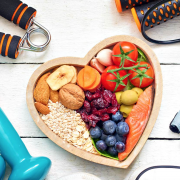Women often ask me what kinds of foods they should eat or what types of exercises they should do to prevent breast cancer. Not at all surprising, as breast cancer is the most feared cancer among women. Indeed, 1 in 8 will be diagnosed in her lifetime.
Truth is, the question of what women can eat or what they can do is always difficult for me to answer. One reason being that I’m not an oncologist. The other being that simply being a woman is in fact the greatest risk factor for breast cancer, and there’s nothing we as women can do about that.
On both personal and professional levels, I’ve encountered so many athletes, fitness enthusiasts and health-conscious women who have or have had breast cancer in spite of following all the spoken and unspoken ‘rules’ for healthy living.
Simply being a woman is in fact the greatest risk factor for breast cancer.
Nevertheless, evidence has long suggested that when coupled with regular screening examinations, healthy lifestyle choices can still greatly influence breast cancer occurrence. In fact, an abundance of research suggests that a healthy lifestyle inclusive of physical activity and sensible nutrition can reduce risk by as much as 30-40%.
Such practices may also reduce breast cancer recurrence and improve survival rates.
For instance, survivors who consume at least five daily servings of vegetables and fruit, and perform at least 30 minutes of moderate to vigorous physical activity 6 days a week have been proven to have a higher 10-year survival rate than those who don’t adhere to such lifestyle practices.
Remarkably, adhering to these practices may also reduce the likelihood of breast cancer-related death by as much as 50%.
So, let’s talk about these practices in a bit more detail.
Engaging in Physical Activity
Physical activity promotes hormonal balance. Imbalances in hormone levels can impact the development of breast cancer, specifically the female sex hormone estrogen. Estrogen circulates in high quantities within a woman’s body between puberty and menopause.
The hormone itself promotes cellular growth in the breasts so any factor that increases estrogen exposure may also increase the risk of breast cancer.
Many types of exercise have been shown to beneficially impact blood estrogen levels. Exercises proven to be most beneficial include: 1) cardiovascular (cardio) exercise, 2) resistance (weight) training, and 3) mind-body exercise. Let’s briefly talk about each of these.
Cardiovascular Exercise
Controlling your weight with regular cardio exercise is a sure way to reduce your risk of breast cancer and even improve your chance of survival if you’ve already been diagnosed. Women who are overweight tend to have the highest levels of estrogen because fat cells themselves produce it.
This is one of the primary reasons why being overweight is so closely linked to increased breast cancer risk.
When it comes to cardio, a daily minimum of 30-45 minutes of moderate-to-vigorous exercises like power walking, jogging, bicycling, swimming, and aerobic dance is sufficient enough for reducing your risk while 45-60 minutes on most days of the week will help keep your body weight under control.
The intensity at which you perform cardio should always exceed the normal demands you place on your body, as more vigorous exercises (walking at 4 miles per hour, jogging at 5 miles per hour, bicycling more than 10 miles per hour, and swimming laps) can result in the greatest reductions in blood estrogen levels.
Related Article: Target Heart Rate: Are You Working Out Hard Enough?
With regular screening examinations, healthy lifestyle choices can still greatly influence breast cancer occurrence.
Resistance Training
When it comes to improving breast cancer survival and reducing overall risk, resistance training is a perfect complement to cardio exercise. This type of training is really the only method of preserving muscle and muscle is known to promote healthy estrogen metabolism and hormonal balance in general.
Due to its effects on muscle, resistance training also elevates the metabolic rate (the rate at which your body burns calories). The more muscle you have, the higher your metabolic rate, which makes it that much easier to control your body weight.
A simple resistance training program involving light-to-moderate loads and a high number of repetitions (12-20 plus) with relatively short rest periods (30-60 seconds) can substantially reduce body fat while also improving muscle endurance and strength.
But, higher intensities of training are associated with the greatest improvements in estrogen metabolism, which puts the odds that much more in your favor.
Related Article: 8 Reasons Why Women Should Weight Train
Mind-Body Exercise
Excessive stress promotes poor health and disease in general. In stressful situations, your body responds by releasing a hormone called cortisol. Long-term exposure to cortisol can have devastating consequences, as elevated cortisol levels promote unhealthy increases in blood sugar levels, blood pressure, and body weight.
If you’ve been diagnosed with breast cancer, you’re probably more susceptible to stress. As such, you may find mind-body exercises like yoga or Pilates to be extremely beneficial. In addition to stress relief, implementing such exercise can also lead to improvements in your balance, posture, and core stability.
Related Article: Stress: A Culprit Behind Weight Gain, Belly Fat, and Chronic Disease
Nutritional Considerations
In addition to regular exercise training, an adequate intake of fresh vegetables and fruit is crucial for reducing breast cancer risk and improving survival from the disease. So, it’s important to make an all out effort to consume a minimum of five daily servings of vegetables and fruit.
Such foods are exceptionally rich in cancer-fighting micronutrients (vitamins, minerals, and antioxidants) that promote estrogen balance and overall good health.
Related Article: Micronutrients: The Nutritional Building Blocks for Good Health
For maximum protection, more is definitely better (9-10 daily servings), especially when it comes to eating vegetables.
You should also consume at least three servings of fiber-rich whole grains (whole oats, oatmeal, and brown rice) along with sizable portions of healthy fat and high-quality protein. Some good sources of fat and protein include nuts, seeds, avocado, olive oil, and oily fish like tuna, salmon, and trout.
Collectively, the nutrients contained in these foods is known to support healthy estrogen metabolism.
Related Article: A Simple Guide to Eating Sensibly
The Net-Net
At the end of the day, since there are several other risk factors linked to an increased risk of breast cancer that are not necessarily under our control (genetics, family history, age, and race), adopting the healthy lifestyle practices I’ve described doesn’t guarantee that you won’t develop breast cancer or even have a recurrence.
But, such behaviors certainly put the odds in your favor, even if you’re at increased risk due to a family history or other factors. Refraining from smoking and cutting down on alcohol use can further lower overall risk. Collectively, such lifestyle practices will help reduce your risk of developing other chronic diseases as well. This is priceless!
Learn More About Prevention
The American Cancer Society recommends yearly clinical breast exams and mammograms starting at age 40 and continuing for as long as a woman is in good health. In addition, women with a family history, a genetic tendency, or certain other factors should be screened with MRI in addition to mammograms.
Women in their 20s and 30s should have a clinical breast exam every three years. In addition, if you are over the age of 20, you should perform regular breast self-exams to become familiar with your breasts and report any changes to your health care provider.







